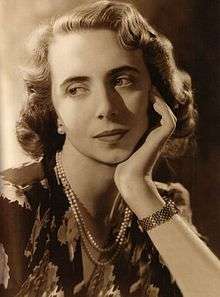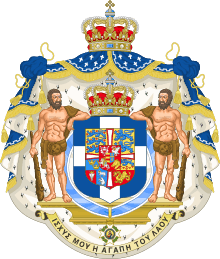Princess Katherine of Greece and Denmark
Princess Katherine of Greece and Denmark[1] (Greek: Αικατερίνη; 4 May 1913 – 2 October 2007), styled in the UK as Lady Katherine Brandram from 1947 till her death, was the third daughter and youngest child of King Constantine I of Greece and Sophia of Prussia.
| Princess Katherine | |
|---|---|
| Lady Katherine Brandram | |
 Princess Katherine in 1937 | |
| Born | 4 May 1913 Athens, Kingdom of Greece |
| Died | 2 October 2007 (aged 94) London, England |
| Burial | 11 October 2007 Royal Cemetery, Tatoi Palace, Greece |
| Spouse | |
| Issue | Paul Brandram |
| House | Glücksburg-Greece |
| Father | King Constantine I of Greece |
| Mother | Princess Sophia of Prussia |
Early life
Katherine was born in the Royal Palace in Athens, a few weeks after her paternal grandfather, King George I of Greece, was assassinated in that country's second-largest city (in the English-speaking world until the late 20th century known as Salonika, namely Thessaloniki). She was baptised on 14 June 1913. Her godparents were Dowager Queen of Greece (her paternal grandmother), Dowager Queen of the United Kingdom (her paternal grandfather's sister and her maternal grandmother's sister-in-law), George V of the United Kingdom (her paternal grandfather's nephew and her maternal grandmother's nephew), Wilhelm II, German Emperor (her maternal uncle), The Greek Navy (represented by the Minister of Marine) and The Greek Army (represented by the Minister of War)
She had five siblings – three brothers (George, Alexander and Paul, each of whom would become King of the Hellenes) and two sisters (Princess Helen, who married Crown Prince Carol of Romania, and Princess Irene who married Prince Aimone of Savoy, Duke of Spoleto). When she was christened, the members of the whole Greek Army and Greek Navy became her godparents. At three years of age, she and her mother were trapped in Tatoi Palace, outside Athens, when a fire broke out. The Queen, carrying Katherine, managed to escape in time.[2]
Life in exile
Her father abdicated in 1917, replaced as king by her brother Alexander. She and her parents were exiled to Switzerland. They were re-instated following Alexander's death in 1920, but Constantine abdicated again in 1922. Exiled again, this time to Sicily, her father died in Palermo in 1923. The family moved to Villa Sparta in Florence, where Katherine took up painting. Her second brother George became King George II in 1922, but was deposed in 1924.
Katherine was educated in England, at a boarding school at Broadstairs and then North Foreland Lodge. Her mother died in January 1932, after which she continued to live at the Villa Sparta with her sister, Helen. She and the future Elizabeth II were bridesmaids at the wedding of her first cousin, Princess Marina, to Prince George in 1934.
Return to Greece and marriage
Her brother George was reinstated as king in 1935, and Katherine returned to Greece with her sister, Irene. She joined the Greek Red Cross when the Second World War broke out in 1939. In 1941, after Greece had been overrun by Axis forces, she fled to South Africa with her third brother, Paul, in a Sunderland flying boat, where she worked as a nurse at a hospital in Cape Town. She heard no news of her sister Helen for four years. She returned to England in 1946, sailing the last leg from Egypt to England on the Cunard liner RMS Ascania. On board, she met Major Richard Campbell Brandram MC (5 August 1911 – 5 April 1994), an officer in the British Royal Artillery. They were engaged three weeks after they arrived in England, but their engagement was announced only in February 1947.[3] On 1 April at the Royal Palace, three weeks prior to the wedding, her brother King George had a stroke and died shortly after in Katherine's presence.[4][5] George was succeeded on the Greek throne by Katherine's third brother Paul, who acted as best man at the wedding, which took place according to schedule on 21 April 1947.
She then accompanied her husband to his new army posting in Baghdad, and they later settled in England.[6] On 25 August 1947, King George VI granted her the rank and title of a duke's daughter and she became known as Lady Katherine Brandram.[7] She and her husband lived in Eaton Square in Belgravia, and later moved to Marlow, Buckinghamshire.
According to her obituary in The Daily Telegraph, "Lady Katherine lived quietly but remained in close touch with her own and the British royal families. She attended the Queen's wedding to Prince Philip (her first cousin), and was a guest at the service to mark Prince Philip's 80th birthday at St George's Chapel, Windsor, in 2001."[2]
After the death of Infanta Beatriz of Spain in 2002, Katherine was the last surviving great-granddaughter of Queen Victoria, as well the last surviving grandchild of Frederick III, German Emperor and Victoria, Princess Royal. She lived for almost 87 years after the death of her brother, King Alexander, and her death left Count Carl Johan Bernadotte of Sweden (31 October 1916 – 5 May 2012) as Queen Victoria's last living great-grandchild.
From the time of the death of her eldest sister Queen Helen, Queen Mother of Romania in 1982, to the time of her own death, she was Queen Victoria's most senior female line descendant. Her death marked the end of all female-line direct descendants of Frederick III, German Emperor and Victoria, Princess Royal.[1]
Issue
Princess Katherine of Greece and Denmark and Major Richard Campbell Andrew Brandram had one child, a son:[1]
- Richard Paul George Andrew Brandram (1 April 1948 – 9 May 2020)[8][9] he married Jennifer Diane Steele on 12 February 1975 and they were divorced in 1993. They have three children and three grandchildren. He remarried Katherine Moreton on 19 September 2009.
- Sophie Eila Brandram (23 January 1981)[1] she married Humphrey Walter Voelcker on 11 February 2017. They have two sons:
- Maximillian Walter Voelcker (4 February 2018)
- Alexander Paul Voelcker (13 May 2019)
- Nicholas George Brandram (23 April 1982)[1] he married Katrina Davis on 10 September 2011 and they were divorced.
- Alexia Katherine Brandram (6 December 1985)[1] she married William John Palairet Hicks on 29 April 2016. They have one daughter:
- Theodora Katherine Anne Hicks (6 March 2019)
- Sophie Eila Brandram (23 January 1981)[1] she married Humphrey Walter Voelcker on 11 February 2017. They have two sons:
Titles, styles, honours and arms
| Styles of Princess Katherine of Greece and Denmark | |
|---|---|
| Reference style | Her Royal Highness |
| Spoken style | Your Royal Highness |
Titles and styles
- 4 May 1913 – 2 October 2007: Her Royal Highness Princess Katherine of Greece and Denmark
- in the United Kingdom: 25 August 1947 – 2 October 2007: Lady Katherine Brandram
Honours
.svg.png)
Ancestry
| Ancestors of Princess Katherine of Greece and Denmark |
|---|
References
- Marlene A. Eilers, Queen Victoria's Descendants (Baltimore, Maryland: Genealogical Publishing Co., 1987), page 165.
- "Lady Katherine Brandram," The Daily Telegraph, 4 October 2007. Retrieved 8 March 2013.
- Van der Kiste, John (1999). Kings of the Hellenes: The Greek Kings, 1863–1974. Sutton Publishing Ltd. p. 177. ISBN 978-0750921473.
- Van der Kiste, p.175
- Vickers, Hugo (2003). Alice: Princess Andrew of Greece. St. Martin's Griffin. pp. 322. ISBN 9780312302399.
- Van der Kiste, p.177
- "No. 38067". The London Gazette. 9 September 1947. p. 4249.
- Romania Regala
- Koenig, Marlene Eilers. "A QVD Death: Paul Brandram (1948-2020)". Royal Musings. Retrieved 21 May 2020.
- "Jewels". Spanish Royals.
- Bricka, Carl Frederik (ed.). "Louise". Dansk Biografisk Leksikon. 5. p. 593.
- Chisholm, Hugh, ed. (1911). . Encyclopædia Britannica. 11 (11th ed.). Cambridge University Press.
- "Olga Constantinovna (1851–1926)". Women in World History: A Biographical Encyclopedia. Gale Research. 2002.
- Meisner, Heinrich Otto (1961), "Friedrich III", Neue Deutsche Biographie (NDB) (in German), 5, Berlin: Duncker & Humblot, pp. 487–489; (full text online)
- Louda, Jiří; Maclagan, Michael (1999), Lines of Succession: Heraldry of the Royal Families of Europe, London: Little, Brown, p. 34, ISBN 978-1-85605-469-0
External links
![]()

